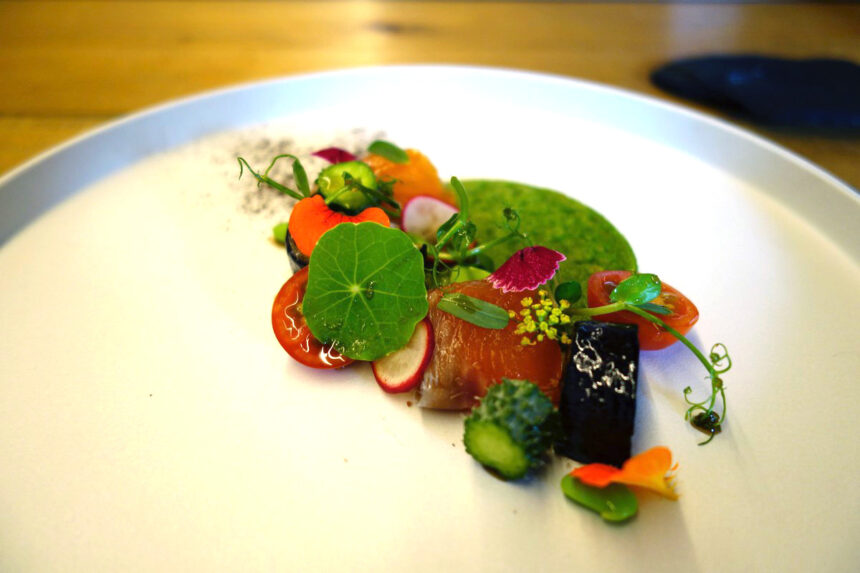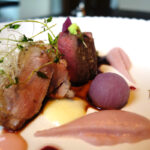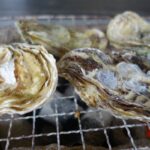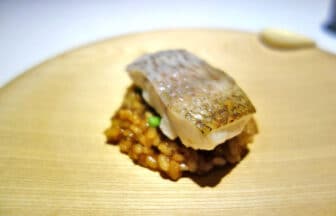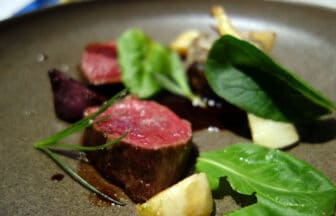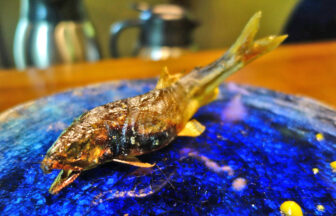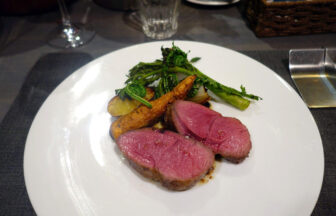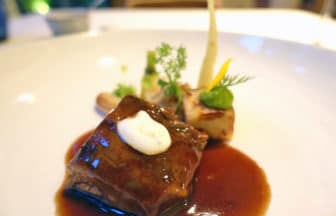In the 2022 edition of the Michelin Guide, ‘TOYOSHIMA’ in Lake Kawaguchi, which has joined the ranks of restaurants representing local gastronomy, received the Terroir Award alongside ‘Kamakura Kita Jima’ in Kanagawa and ‘Satoyama Jotto – Hayasae Megumi’ in Niigata.
Let’s take a closer look at ‘TOYOSHIMA.’
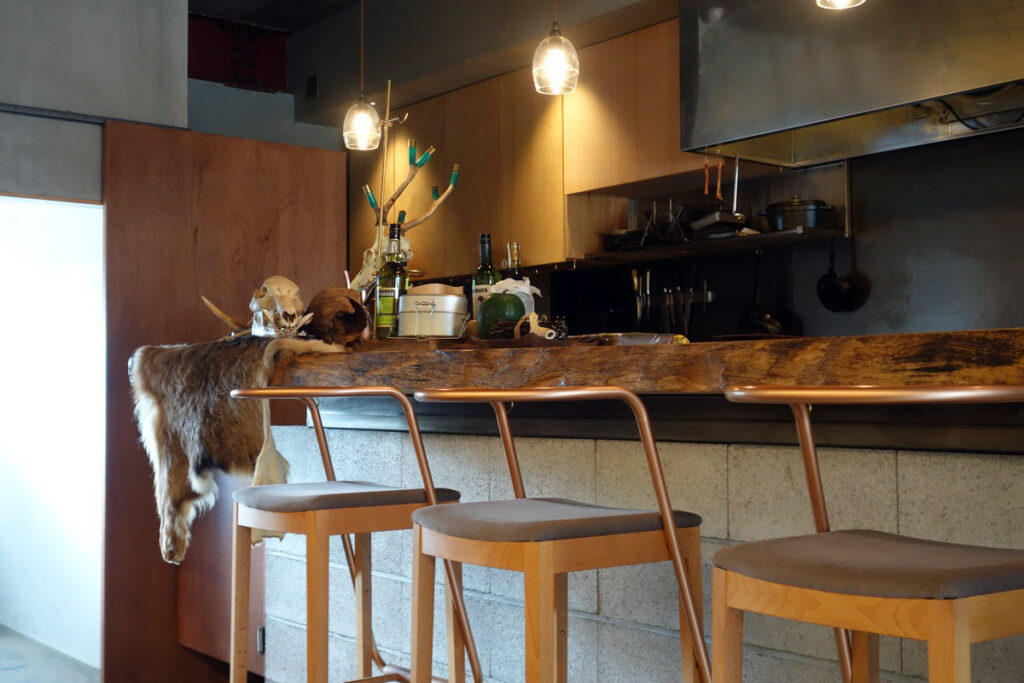
Ave. Budget: Lunch 5,00057,000 JPY, Dinner 10,000-15,000 JPY / “”gault-millau 2023” 3 tok
Check information on Tabelog
Restaurant features
Destination restaurants, local gastronomy, farm-to-table, terroir; there are various terms for it, but within these categories, is this restaurant one of the most noteworthy currently?
Regarding ‘toyoshima’ in Lake Kawaguchi, I heard such rumors from people in Toyohashi and Kiyosato, and it put me in a mood of, “Yes, I’ve found another restaurant of my liking!” I enjoy hiking, but I have no intention of climbing Mt. Fuji, and since it’s relatively close to the Tokyo metropolitan area, I thought I could go anytime. Paradoxically, I couldn’t find the opportunity to visit Lake Kawaguchi and ended up being indecisive.
Amidst all of this, it became an assertion rather than a question like, “Isn’t it just one of them?” ‘toyoshima’ received the Terroir Award in the 2022 Gault & Millau Guide, alongside ‘Kamakura Kitajima’ in Kanagawa and ‘Satoyama Jujo – Sanae Kyo -‘ in Niigata.
Well, with that recognition at such a high level already, I decided to make the trip to Fuji.
Both lunch and dinner are exclusively offered as courses.
As is my usual style, this was a spontaneous solo trip, so I inquired, “Is it okay for one person?” The response was, “Lunch is fine.”
For both lunch and dinner, it seems they only offer omakase (chef’s choice) courses, with lunch options at 4,000 yen and 7,000 yen.
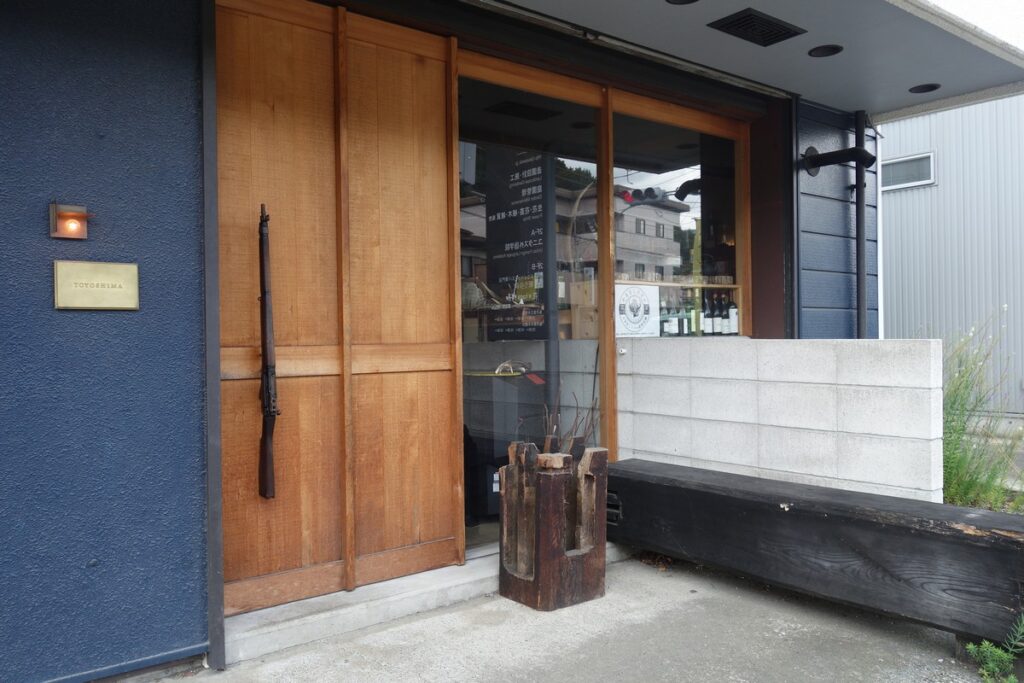
One thing I regret is that I drove to the restaurant. I was staying in Fujiyoshida, so I could have easily taken the train to Kawaguchiko Station, which is just one stop away on the Fuji Kyuko Line, or it’s a 5-minute walk from the station. I was a bit flustered when I realized this on my way there.
Consequently, I had to pass on one of the restaurant’s attractive features: pairing their dishes with Yamanashi-made Japanese wine. I managed with non-alcoholic options, but they didn’t have a wide variety of non-alcoholic wines or cocktails, so I decided to go through the three variations of ginger ale they had.
Starting with this one:
Sansho Ginger
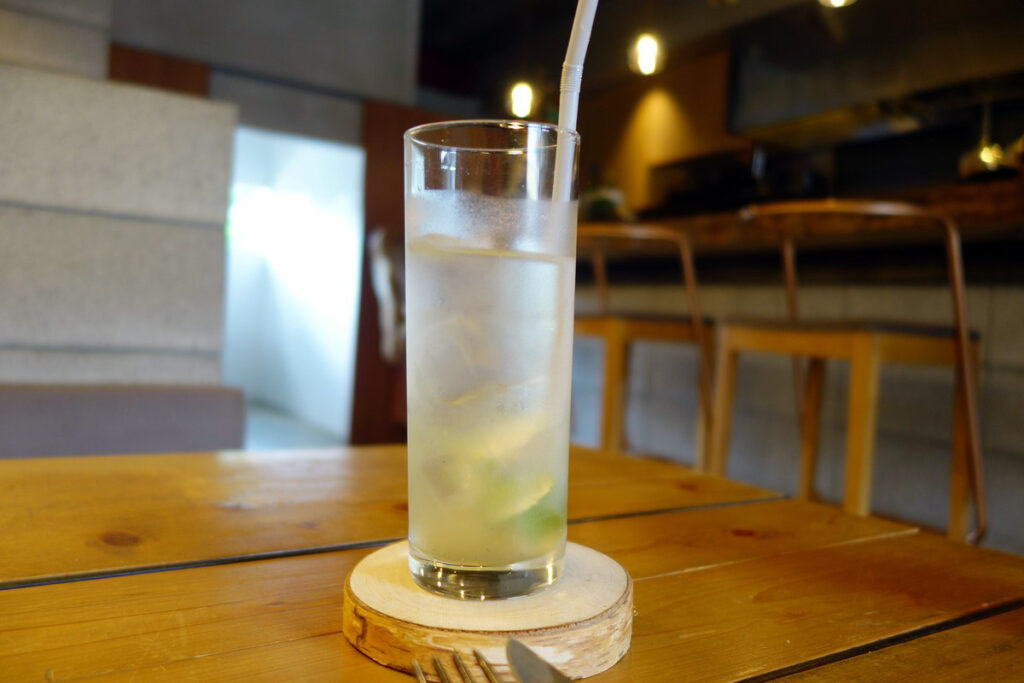
It has a refreshing taste with a hint of black text incorporated.
Amuse-bouche 1
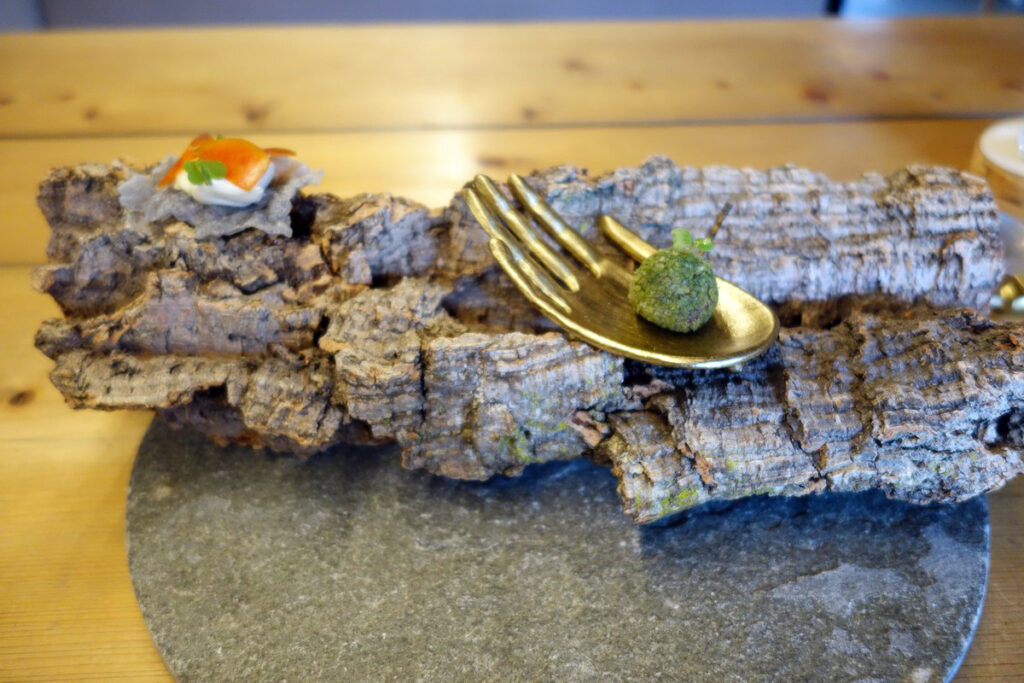
Designed to resemble a forest, the front is a wild boar croquette.
It’s even garnished with moss.
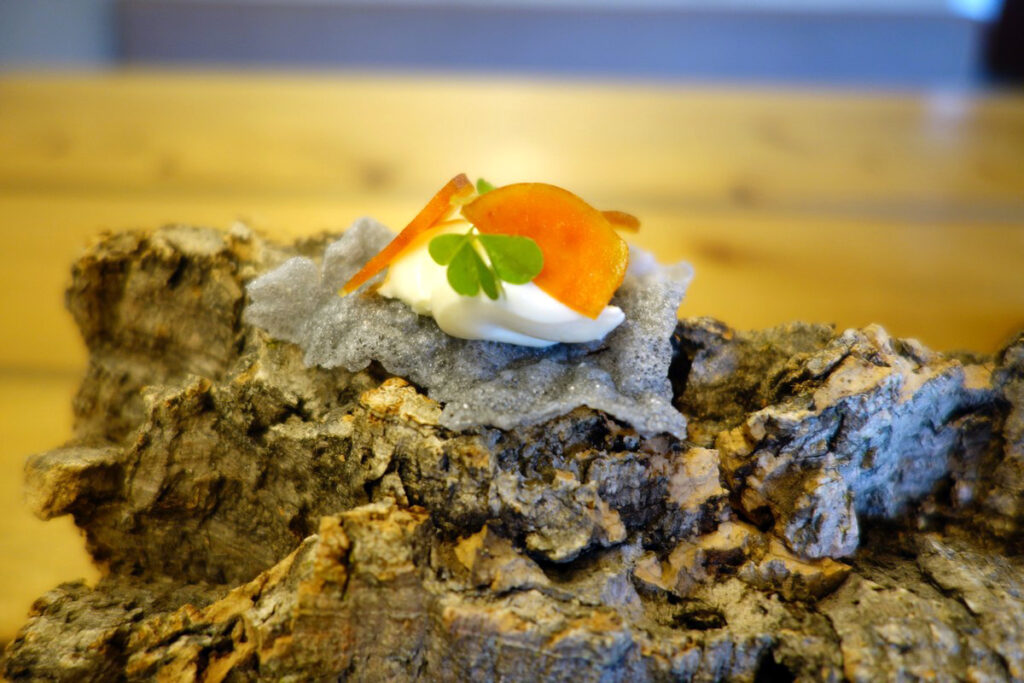
In the back, there are rice chips with sour cream and homemade caviar.
Amuse-bouche 2
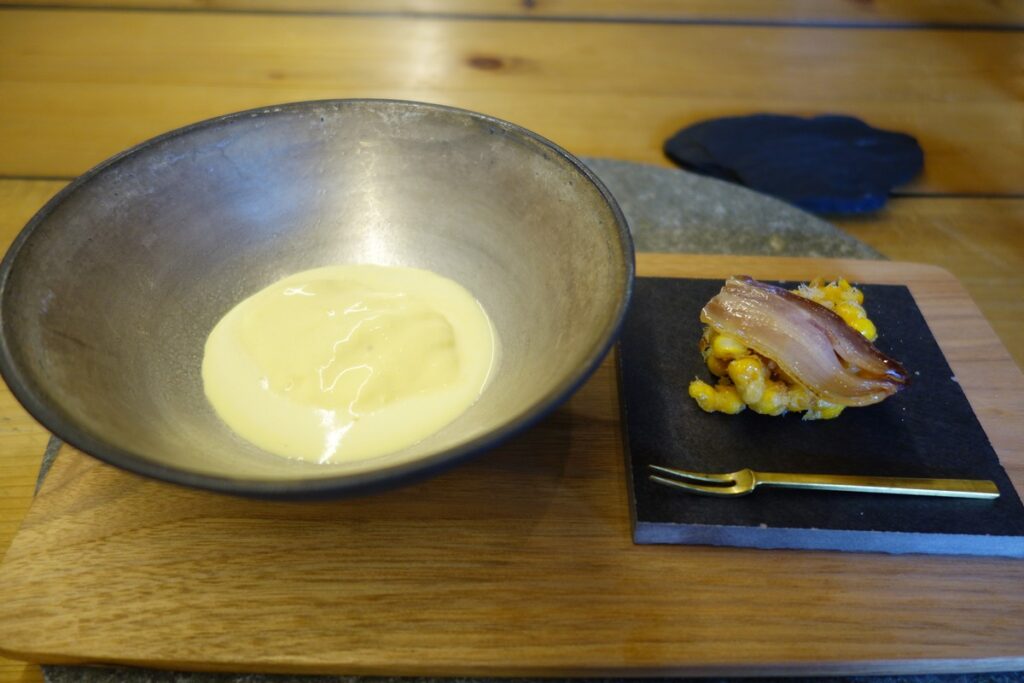
Two dishes made from freshly picked corn.
Whether you call it an amuse-bouche or an appetizer, it’s not a big issue, but the restaurant staff described it as “another amuse-bouche-like dish.”
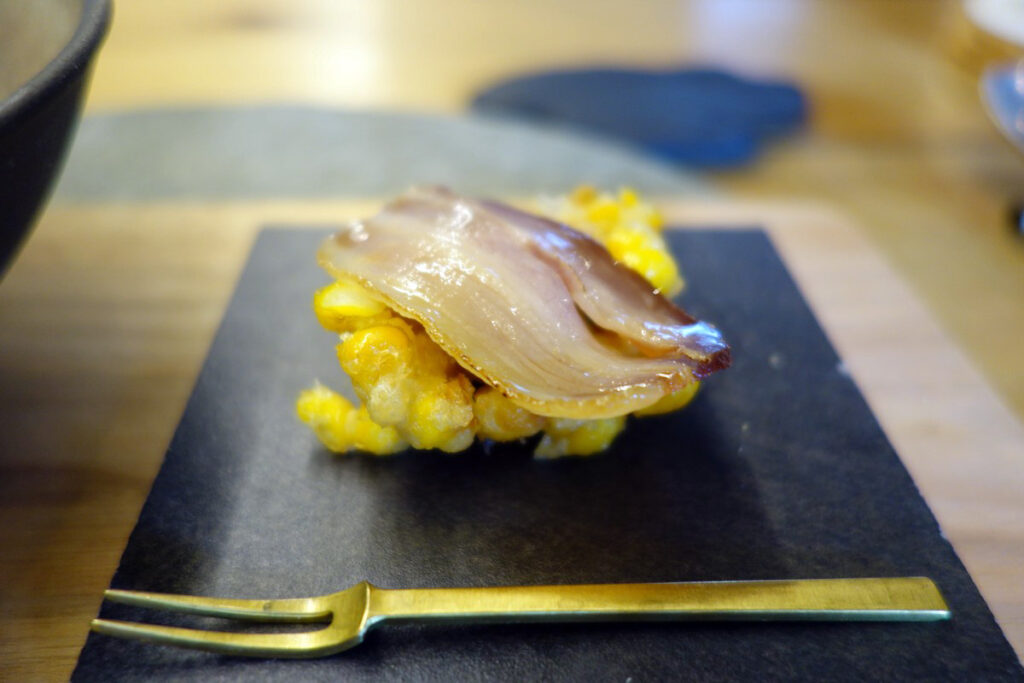
On the right, there are fritters.
These fritters featured wild boar meat that had been marinated in miso for about a year, lightly seasoned with homemade kelp salt.
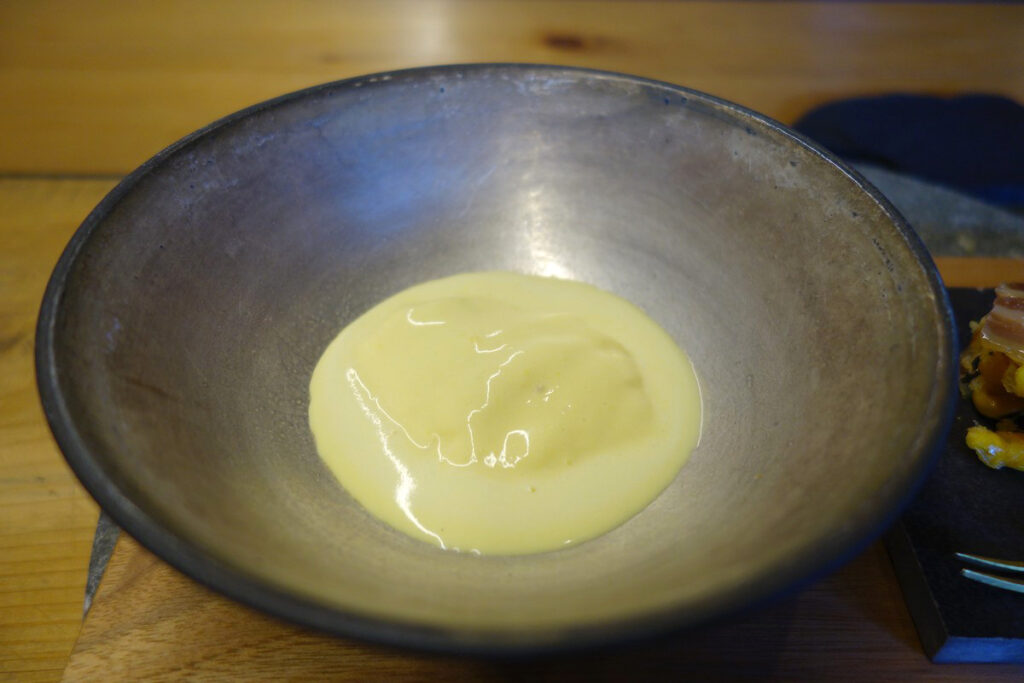
Next up, a chilled soup.
It seems to be primarily flavored with corn, but what’s interesting is the varying texture achieved by freezing and mixing it.
They also mentioned that they use spring water from a nearby shrine, which shares the same aquifer as the cornfields.
Caprese
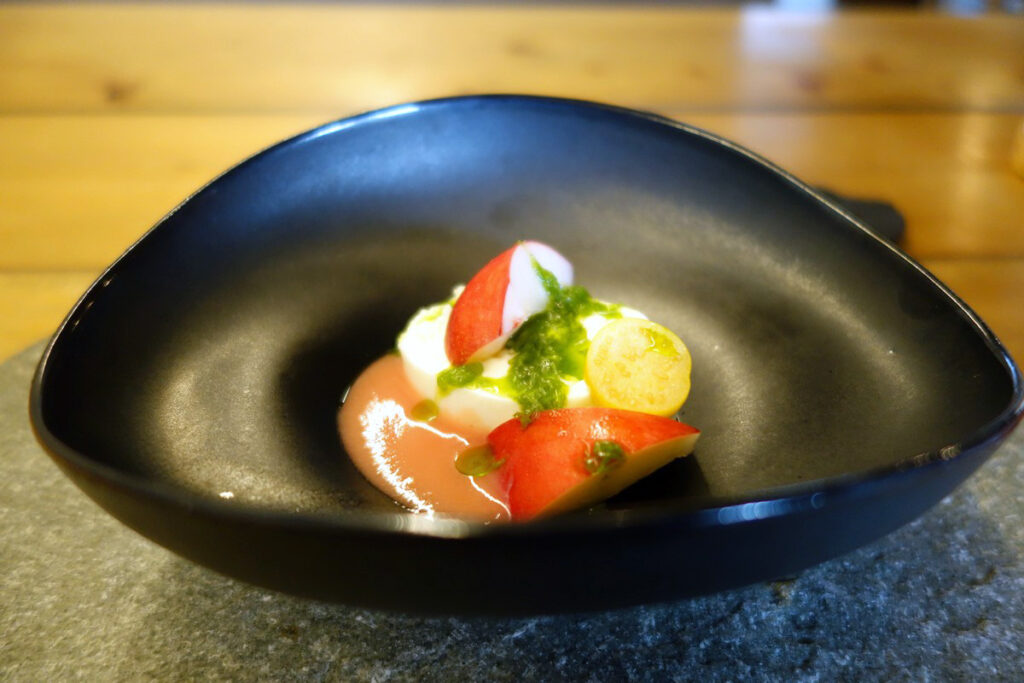
Personally, one highlight from the first part of the meal was this Caprese.
They fermented the tomatoes with rice koji and used nobiru (Japanese horned cucumber) instead of basil.
It’s finished with nectarines and edible hozuki (ground cherries).
Visually, it’s a Caprese, but the clever substitutions create a new sensation.
Homemade Bread
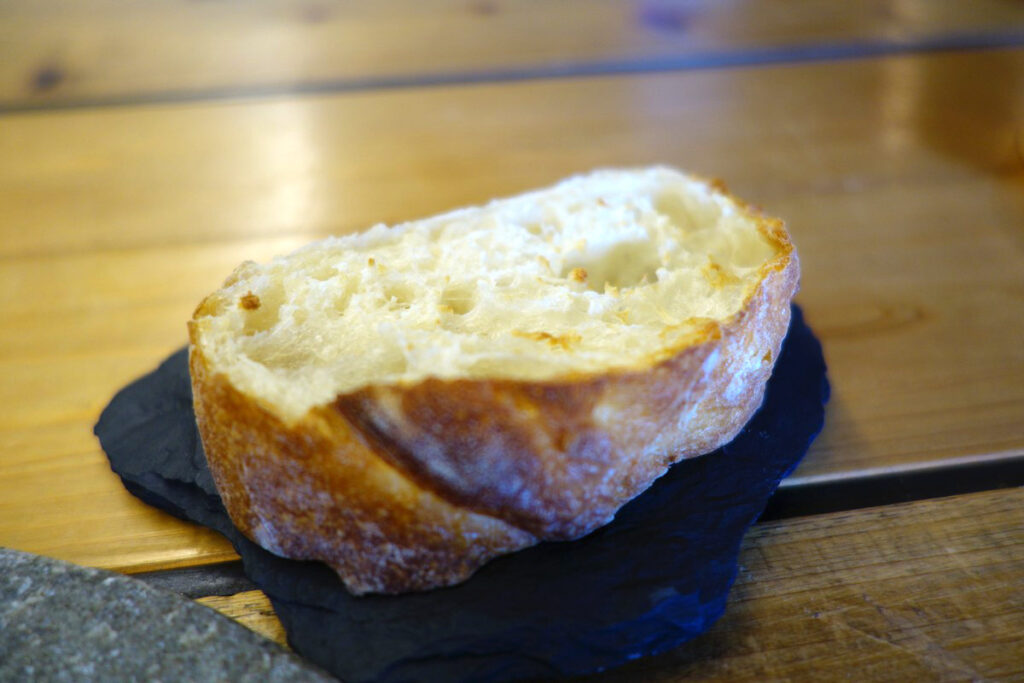
The bread is baked to order, and it’s delightfully chewy with a rich buttery flavor.
It’s also sugar-free. They mentioned that they sell the bread separately if you make a reservation.
Peach Ginger
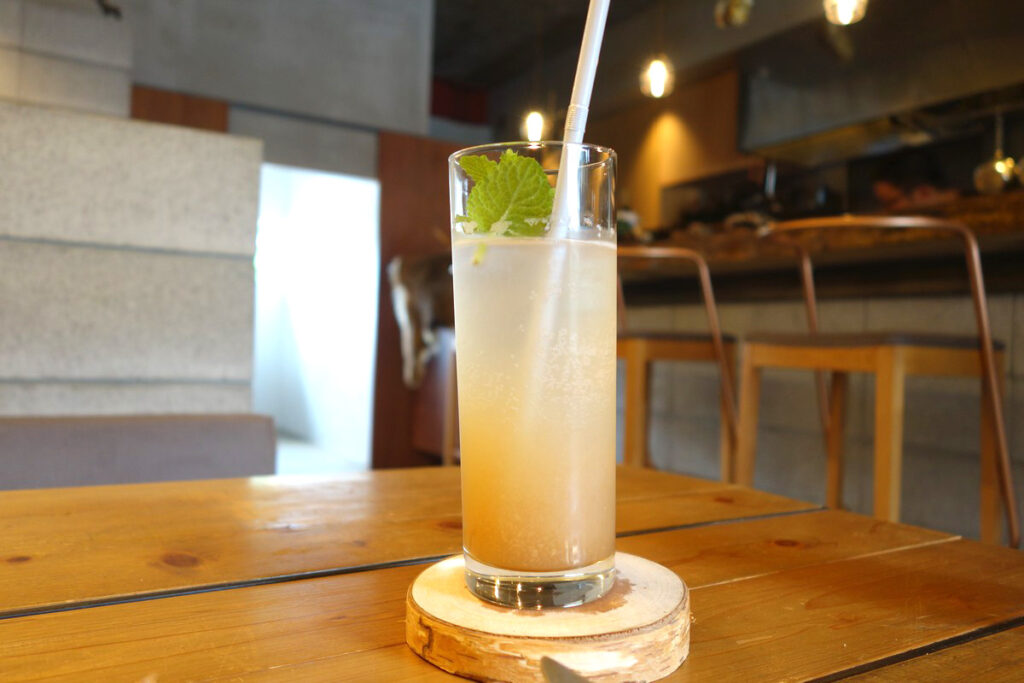
When you think of summer in Yamanashi, you think of peaches!
Salmon Galette
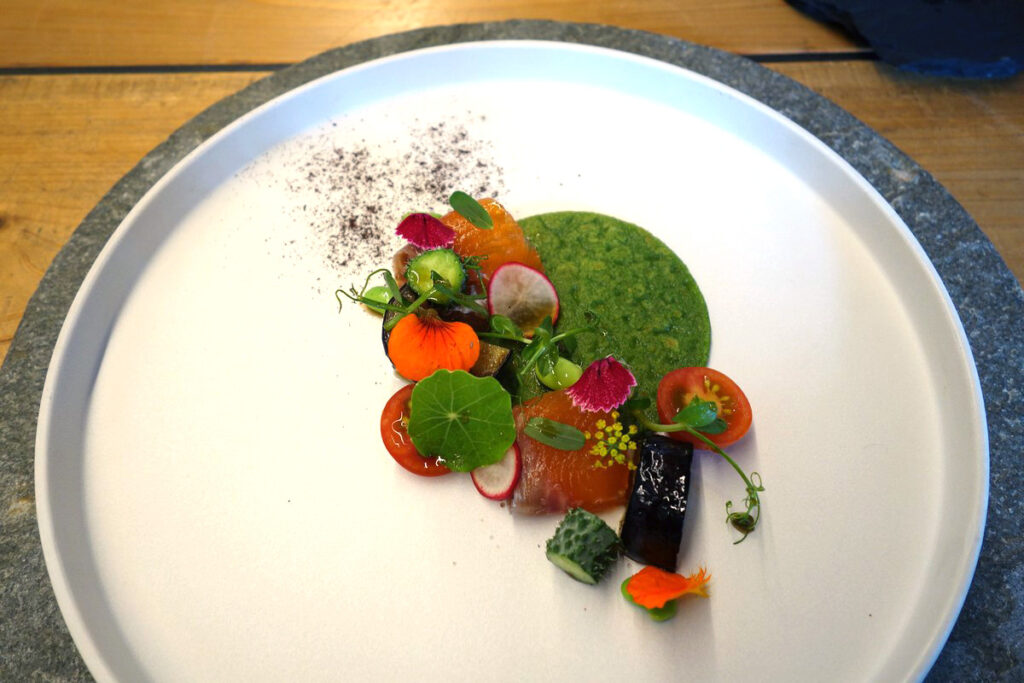
A seafood appetizer featuring local ingredients. The salmon is smoked with pine cones, and the galette includes minced garland chrysanthemum. The vegetables are sourced from their own garden and served with homemade perilla salt.
Soup Course
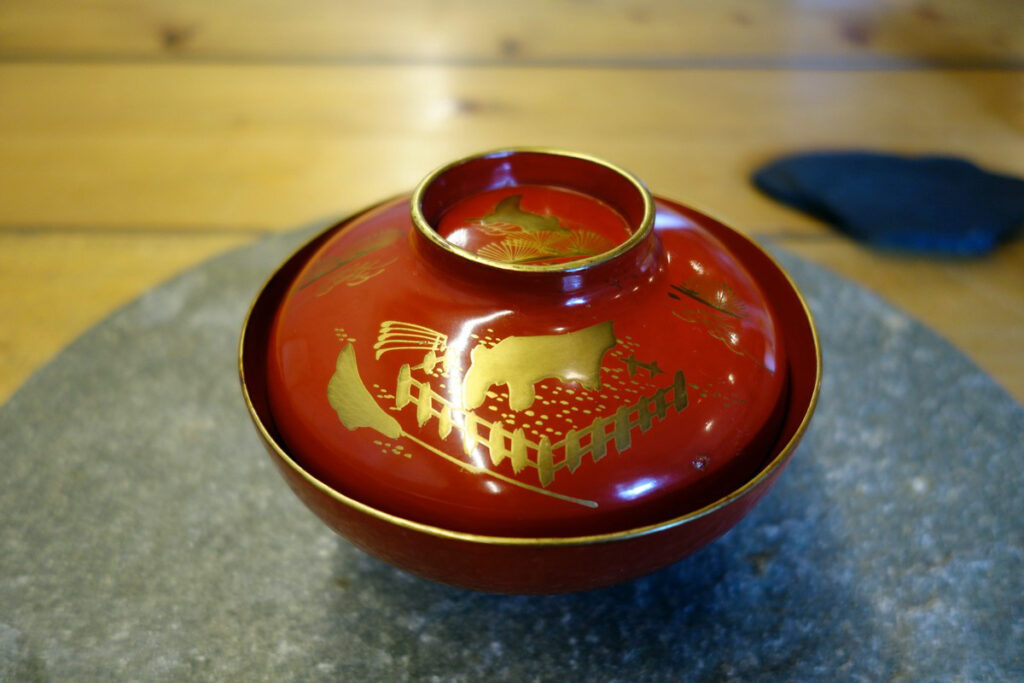
Following this, I was curious about what would come next, and to my surprise, it was a soup in Japanese style!
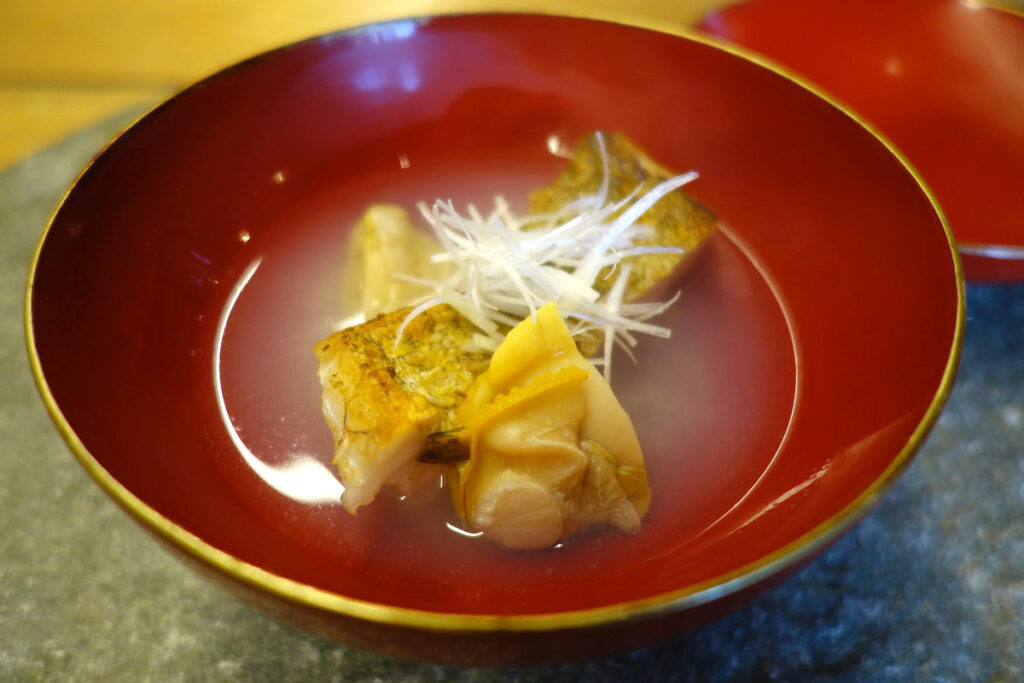
It featured a broth made from a three-day aged grouper, focusing on extracting flavor from its bones.
They used only the natural saltiness from shellfish and similar ingredients and added no seasonings.
It wasn’t quite French, nor was it traditional Japanese; it was a simple yet unique umami experience, perhaps best described as modern Japanese cuisine.
Pâté en Croûte
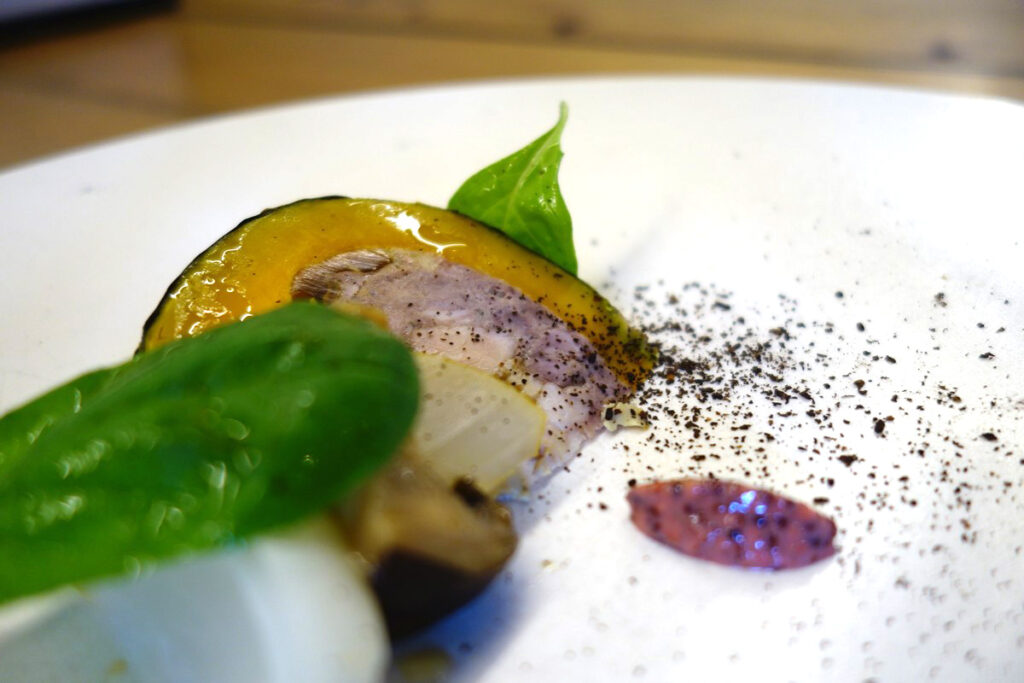
Their pâté en croûte is not wrapped in pastry but instead in pumpkin.
Inside the pâté, there’s a blend of wild boar meat, deer, and duck.
It’s accompanied by vegetables such as cucumber and turnip, which are favorites of wild boars.
The use of pumpkin, known to be a preferred food of wild boars, adds a distinctive touch to the dish.
It’s garnished with berry sauce and cabbage powder.
Homemade Bread
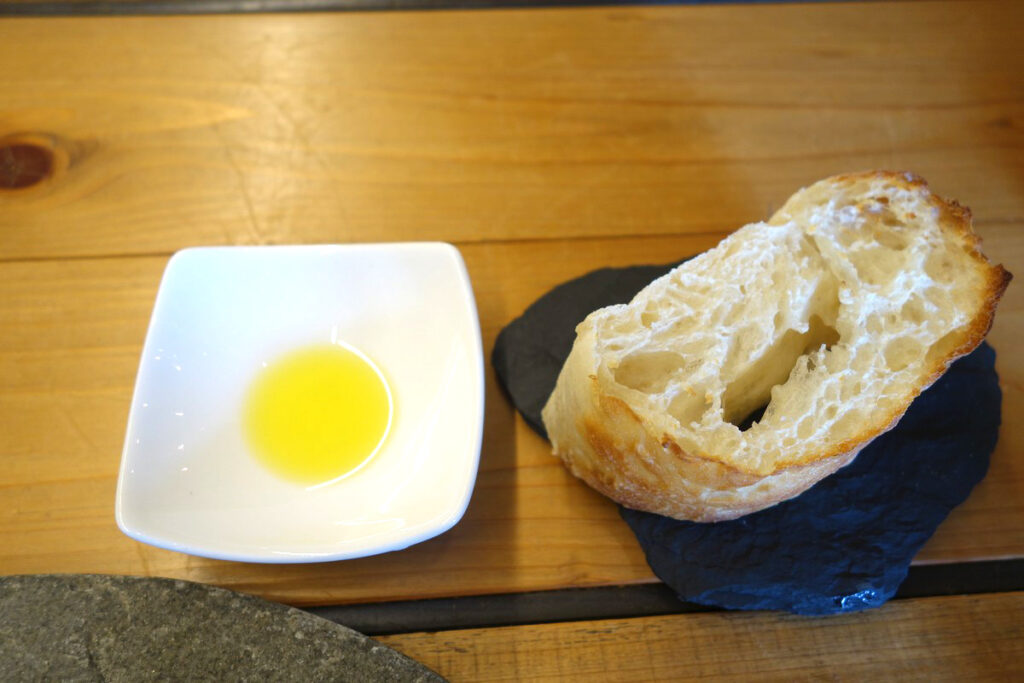
Before the main meat course, they serve a second helping of bread.
The accompanying olive oil is produced by a former member of the now-disbanded Japanese band Remioromen.
Palate Cleanser
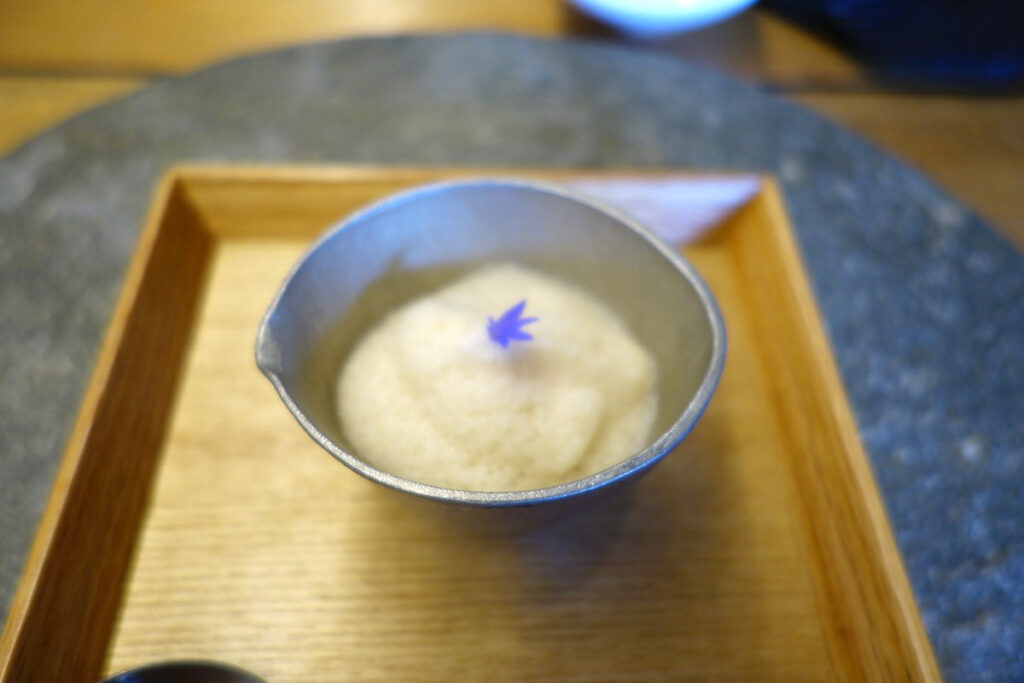
A granite made using Yamanashi’s famous craft beer, Space Beer.
It carries a distinct beer bitterness that’s quite refreshing.
Lamb & Ginger
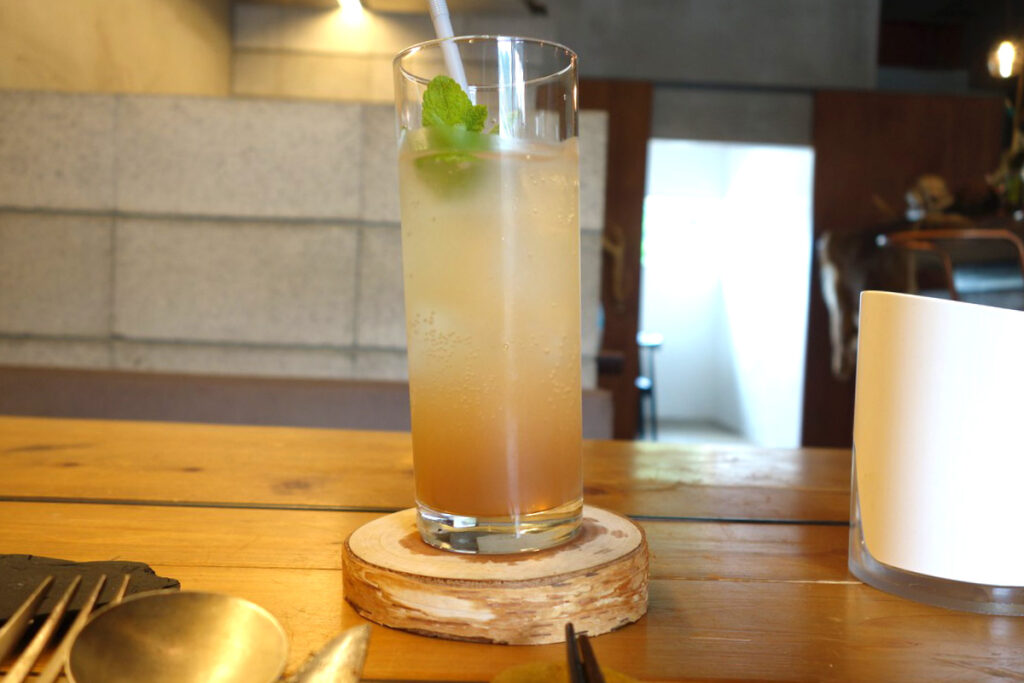
Meat Course
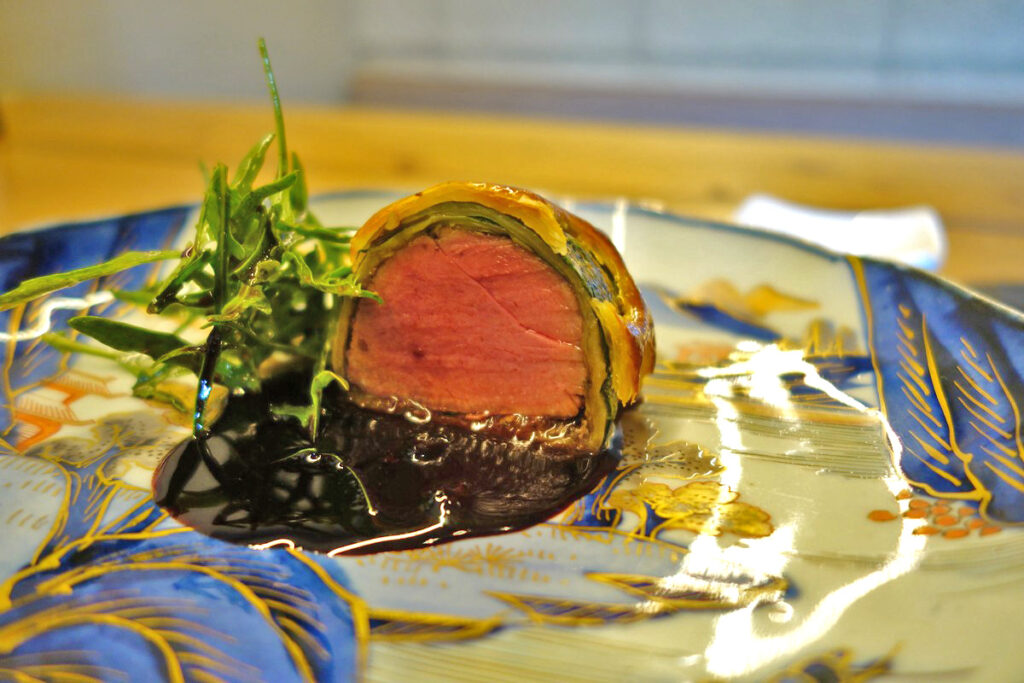
Venison cooked slowly at low temperatures.
Although it’s enclosed in pastry, the chef mentioned, “We don’t want it to be too heavy, so we keep it small in size.”
The pastry is mesh-like, with leaves underneath.
It’s served with a red wine and fermented berry sauce. The accompanying sylva chives, thanks to their homegrown origins, added a wild touch.
Dessert

Ice cream made from Yatsugatake yogurt.
Served with homemade mint and the earlier-mentioned olive oil.
Herbal Tea and Petit Fours
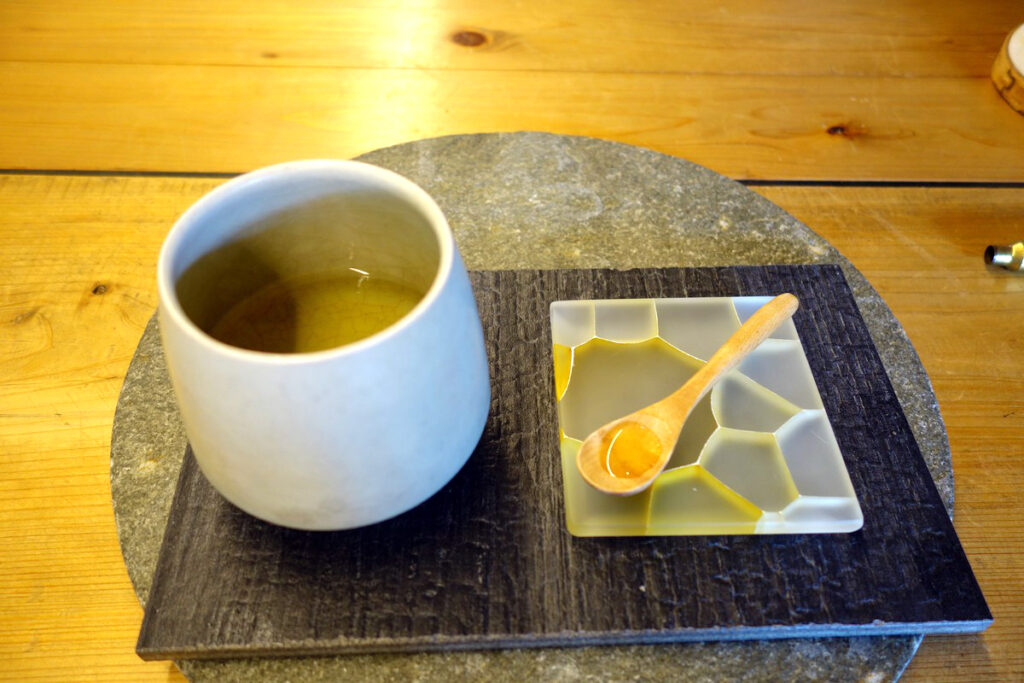
Even the final tea was special. Instead of a selection, it’s herbal tea only.
It’s packed with mountain scents like black mint, white birch, and pine needles. It comes with homemade honey.
Chef Toyoshima Masaya is not only a chef but also a hunter, farmer, and beekeeper, I hear.
While I’ve come across chefs who hunt and tend to gardens, meeting a chef who keeps bees is a first for me. Perhaps it’s this dedication that imbued the experience with a Zen-like simplicity, reminiscent of the world of tea ceremonies.
In my personal opinion, it’s one of a kind, one of the biggest discoveries in recent years.
While savoring the honey, upon reflection, you realize, “This place might be doing something unexpectedly remarkable.” During the meal, it flowed naturally, which made the gap all the more intriguing.
In some ways, this was a type of cuisine I’d rarely encountered in Japan.
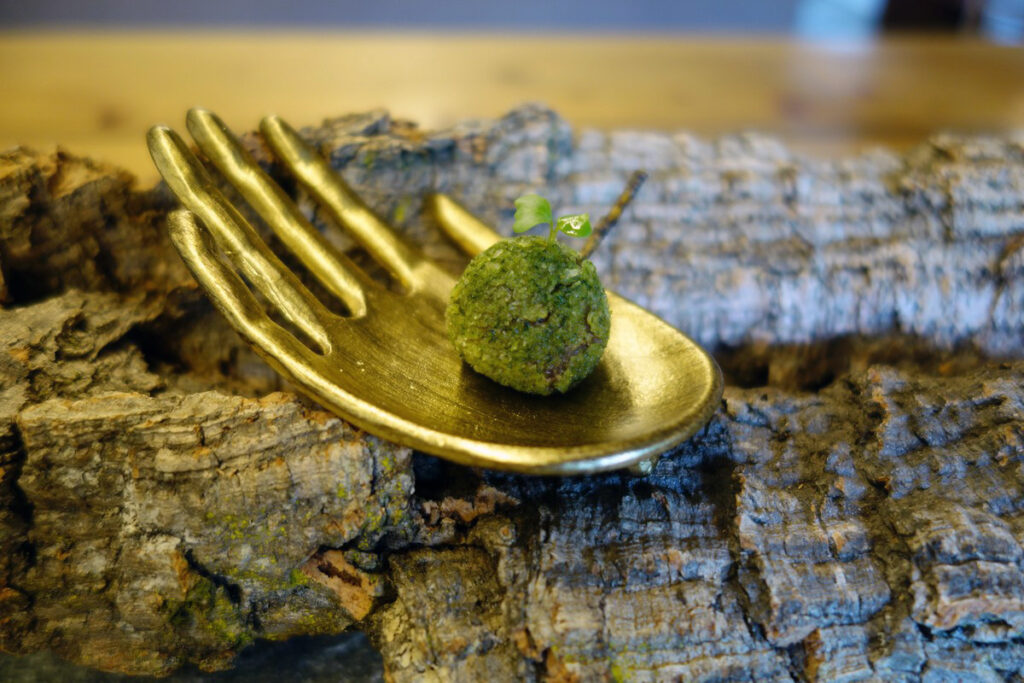
The notion that Japanese people aren’t good at creating from 0 to 1 is an idea I’ve often heard. I’m not necessarily endorsing that view, but it’s safe to say that there are elements of truth in it.
When I first became interested in gastronomy, I began by exploring not just Japan but all of Asia because I found that when you shift your focus slightly away from “delicious,” you often discover more interesting things. In terms of technical quality, Japan was undoubtedly outstanding.
However, in terms of creativity, aside from a few select restaurants, I found that other Asian countries often had more interesting establishments. After experiencing the courses at “toyoshima,” I wondered if the difference lay in the sense of “replacement”?
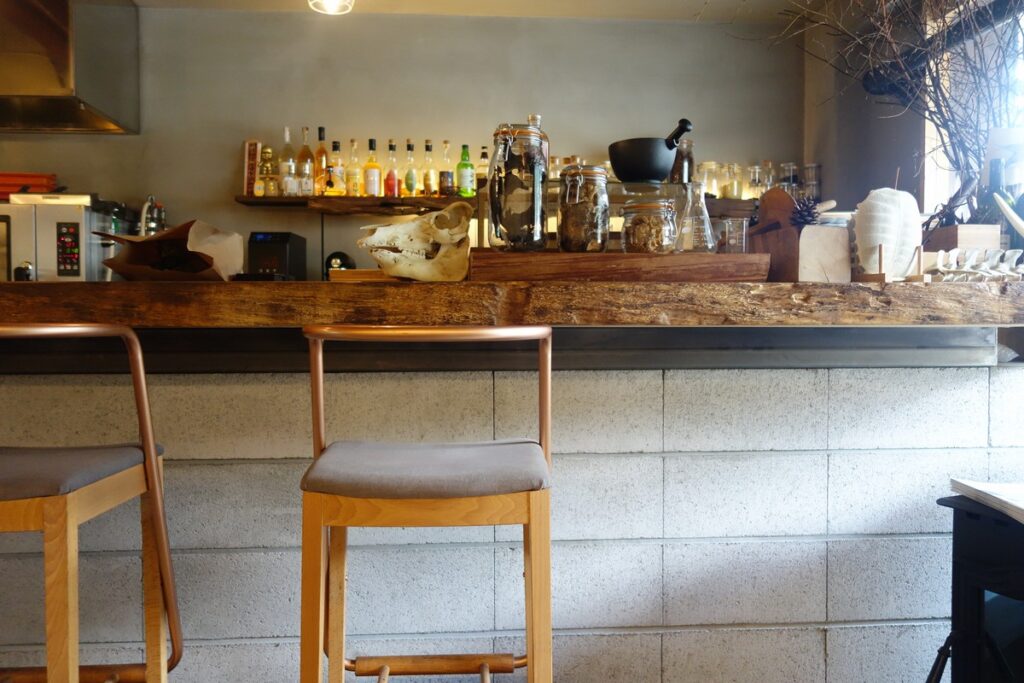
Restaurants like “Gaggan,” which had long been at the forefront of Asia, also exhibited this trait. They used the framework or template, if you will, that they had acquired from places like Spain’s “El Bulli,” but they boldly replaced the content. That’s what made Asian gastronomy in the past decade so exciting.
So, while they inherited the spirit, they continued to create new cuisines. In the case of “Gaggan,” they transformed Indian cuisine.
Therefore, they weren’t doing 0 to 1 creativity; they were more like 2 to 5 or even higher.
n contrast, many Japanese gastronomy establishments didn’t exhibit this kind of boldness. Even when they emphasized “local production for local consumption,” it often meant using local ingredients but aiming for the taste of famous European establishments.
Even if the parts of the ingredients were replaced, the ultimate goal remained unchanged. If the details had changed, it would have been acceptable to replace the answer as well. In essence, rather than striving for 0 to 1 or even 2 to 5, they seemed to be fixated on 6 to 10.
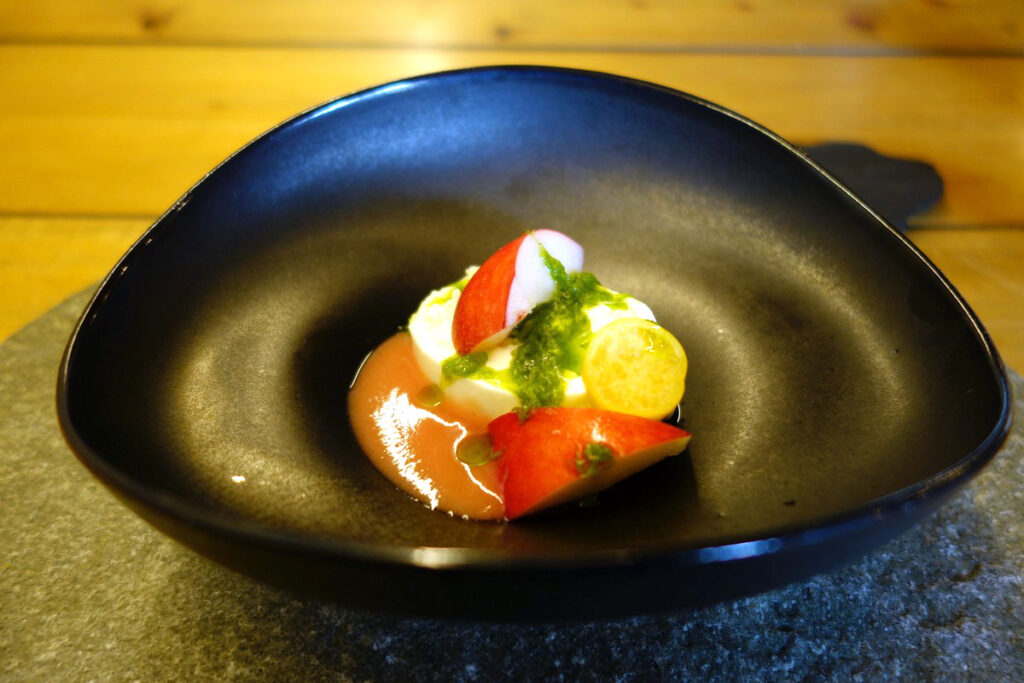
For example, consider the “Caprese” from that day. While it employs the appearance of a Caprese, if you were asked whether it’s actually a Caprese, you’d likely think it’s something entirely different.
However, it’s delicious.
This restaurant seems to ask, “Is it okay if the goal we’re striving for gets replaced?” I had forgotten about this concept because I haven’t been overseas recently. It’s something I was reminded of in Lake Kawaguchi, which is so close yet so far.
I sincerely hope that this boldness spreads to many other restaurants.
Menu
【Lunch】
“Chef’s Selection Course” ¥4,000/¥7,000
【Dinner】
“Chef’s Selection Course” ¥7,000/¥10,000
*The menu and prices are provided for reference only. Please keep in mind that they may change depending on the season and the availability of ingredients.
How to make a reservation
Reservations are required for both lunch and dinner by the day before. By phone.
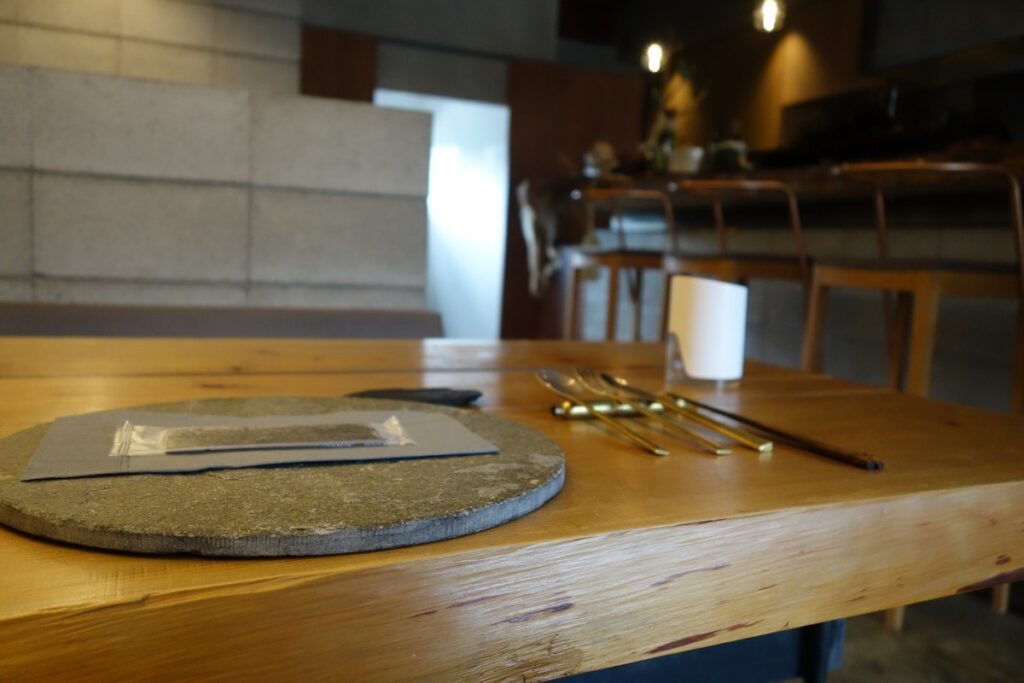
Map/Access
About 5 minutes walk from Fujikyuko Kawaguchiko Station.
–Restaurant Information on “Toyoshima”–
Business Hours: Lunch 11:30 AM – 1:30 PM (Last Order), Dinner 6:30 PM – 11:00 PM (Last Order at 8:00 PM) *Reservations are required for both lunch and dinner, please make them in advance.
Closed: Sundays and Mondays
Phone Number: 0555-75-0850
Address: 3681-2 Funatsu, Fujikawaguchiko, Minamitsuru District, Yamanashi 401-0301, Japan
▽Related article▽
